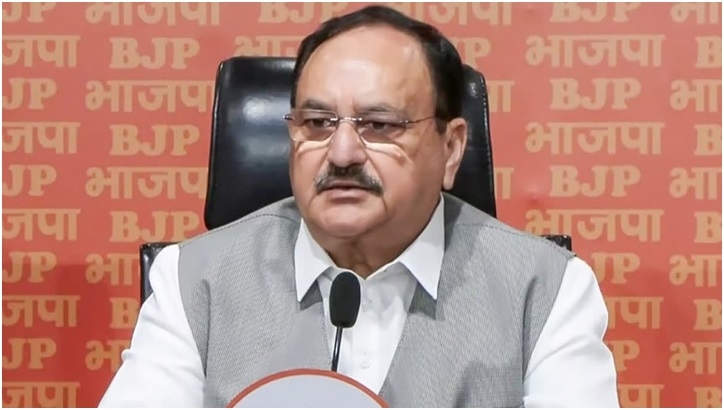Union Health Minister Nadda Urges CMs To Stay Vigilant On Rising Dengue, Malaria Cases
Total Views |

New Delhi: Union Health Minister JP
Nadda on Thursday issued an advisory to all chief ministers urging them to
remain vigilant in the coming months and to intensify preventive measures as
well as community awareness activities for effective control of dengue and
malaria, as such cases have registered a sharp rise in different places across
the country.
At a review meeting, Nadda took stock
of the current status and key challenges in the prevention and control of
dengue and malaria. He urged states, local bodies and communities to intensify
preventive and control measures, particularly during this high-risk period, to
safeguard public health and sustain the gains made in reducing the burden of
vector-borne diseases.
In the meeting, attended by Union
Health Secretary Punya Salila Srivastava and senior officers of the health
ministry, Nadda stressed the need for urgent and coordinated action against
vector-borne diseases and advised state health ministers to personally review
the situation and prepare action plans within 20 days, while municipal
corporations, panchayats and local bodies were asked to intensify community
awareness drives. "Hospitals, including those under the Central
government, must ensure adequate drugs, diagnostics, beds and mosquito-free
premises," Nadda said.
With water stagnation following recent
rains creating breeding sites, states and local bodies were asked to step up
preventive measures. Intensive IEC and social media outreach will continue to
promote community participation and personal protection.
Nadda also instructed
that a high-level review meeting should also be undertaken specifically for
Delhi and NCR to closely assess the dengue situation and ensure advance
preparedness.
The health minister underlined that
India has made significant progress in combating malaria. "The country has
achieved a reduction of over 78% in malaria cases and nearly 78% in
malaria-related deaths between 2015 and 2024. Further, 160 districts have
reported zero malaria cases between 2022-24, and 33 states/UTs have achieved
Annual Parasite Incidence (API) less than one, except three states," he
added.
Nadda noted that all states and UTs
(except Ladakh) are endemic to dengue and chikungunya, and the risk of
outbreaks is highest in the monsoon and post-monsoon period.
The National
Dengue Control Strategy is being implemented through State Vector-Borne Disease
Cells with a focus on surveillance, case management, vector control,
inter-sectoral coordination and community awareness, he added.
As major cities across have been
witnessing a rise in malaria cases, healthcare experts said the life-threatening
parasitic disease has seen localised spikes, especially during the monsoon
season, which is often tied to flooding and wet conditions that favour mosquito
breeding. Data shows that metropolises like Mumbai, Delhi, Noida, and Ghaziabad
have been witnessing a spike in malaria cases with authorities having initiated
a massive anti-malaria campaign in affected areas.
Maharashtra registered a significant
4,471 malaria cases up to June 14, up from 3,954 cases in the corresponding
period last year. while Delhi's count was 264 this year. As per data, Ghaziabad
has reported 56 malaria cases till September with Noida registering 80 cases
till early September.
Though the official number of malaria
cases in Bihar has not been compiled to date, statistics revealed that the
state has witnessed more than 8,000 malaria cases in the last four years, with
districts like Nawada (2,712), Aurangabad (2,052), Gaya (1,436) and Jamui
(1,514) registering the maximum. "India’s exit from the WHO's High Burden
to High Impact (HBHI) group in 2024 was a major milestone, reflecting a 69%
drop in malaria cases and a 68% fall in mortality between 2017 and 2023, driven
by strategies like "Test, Treat, Track," robust surveillance,
insecticide-treated nets, artemisinin-based therapies, and targeted
interventions," said renowned health expert Dr Tamorish Kole.
However, he said recent spikes
highlight the fragility of these gains, as extreme weather, flooding, and poor
drainage create breeding grounds for mosquitoes. "While the overall national
trajectory remains positive, these localised resurgences underline the need for
continued vigilance, adaptive surveillance, and stronger health system
responses to sustain progress and prevent backsliding on the path to malaria
elimination," he said.
Dr Kole said India's malaria spike
this year stems from a mix of environmental and infrastructural challenges.
"The early and heavy monsoon, coupled with flooding and waterlogging, has
created extensive breeding grounds for mosquitoes across both urban and rural
areas. Cities like Delhi, Mumbai, Pune and Noida have seen sharp spikes as
stagnant water accumulated in streets, housing societies, and slums," he
said.
"The heavy and prolonged monsoon
with flooding in 2025 created widespread open stagnant water bodies, which may
be more favourable for Anopheles breeding (malaria vector) than for Aedes
(dengue vector). These trends are compounded by climate change, which has
increased the frequency of erratic, high-intensity rainfall and prolonged
periods of humidity, further accelerating vector growth and transmission,"
said Dr Kole, the former president of the Society for Emergency Medicine,
India.
Although the Union Health Ministry is
yet to compile the state-wise data of malaria cases this year, statistics indicate
that India registered 97,995 malaria cases till June, with five deaths. As many
as 2,55,500 cases were registered in 2024 with 86 deaths, followed by 2,27,564
cases in 2023, with 83 deaths. A total of 1,76,522 cases were registered in
2022 with 83 deaths.
"Preventing the spread of malaria
requires a combined approach of vector control, personal protection, early
detection, and community engagement. Key measures include eliminating stagnant
water, improving drainage, spraying or larviciding breeding sites, and
encouraging the use of insecticide-treated mosquito nets, repellents,
protective clothing, and screened windows and doors — especially during and
after the monsoon when transmission peaks," said Dr Kole.
He said strong surveillance systems
with rapid diagnostic tests, timely treatment with artemisinin-based
combination therapies, and adequate drug supplies at health facilities are also
equally important.

